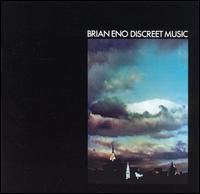Released November 1975 Release date November 1975 | Length 54:07 | |
 | ||
Recorded Side A 9 May 1975Side B 12 September 1975 Discreet Music(1975) Before and After Science(1977) Genres Ambient music, Classical music Similar Brian Eno albums, Ambient music albums | ||
Discreet Music (1975) is the fourth studio album by the British musician Brian Eno. While his earlier work with Robert Fripp on (No Pussyfooting) and several selections from Another Green World feature similar ideas, Discreet Music marked a clear step toward the ambient aesthetic Eno would later codify with 1978's Ambient 1: Music for Airports. It is also Eno's first album to be released under his full name "Brian Eno" as opposed to his previous rock albums released simply under the name "Eno".
Contents
Background and recording
Brian Eno's concept of ambient music builds upon a concept composer Erik Satie called "furniture music". This means music that is intended to blend into the ambient atmosphere of the room rather than be directly focused upon. Like Satie's notion of music that could "mingle with the sound of the knives and forks at dinner" Discreet Music was created to play in, and blend with, the subtle background audio of various, or any given, situation.
The inspiration for this album began when Eno was left bed-ridden in a hospital by an automobile accident and was given an album of eighteenth-century harp music. After struggling to put the record on the turntable and returning to bed, he realised that the volume was turned down (toward the threshold of inaudibility) but he lacked the strength to get up from the bed again and turn it up. Eno said this experience taught him a new way to perceive music:
"This presented what was for me a new way of hearing music—as part of the ambience of the environment just as the color of the light and the sound of the rain were parts of that ambience."
This album is also an experiment in algorithmic, generative composition. His intention was to explore multiple ways to create music with limited planning or intervention. Nicole V. Gagné described the album as "a minimalist work using tape-delay and synthesizer" that would lead to Eno's further experiments in ambient music.
The A-side of the album is a thirty-minute piece titled "Discreet Music". It was originally intended as a background for Robert Fripp to play against in a series of concerts. The liner notes contain a diagram of how this piece was created. It begins with two melodic phrases of different lengths played back from a synthesizer's digital recall system (the equipment used in this case was an EMS Synthi AKS, which had a then-exotic, built-in digital sequencer). This signal is then run through a graphic equaliser to occasionally change its timbre. It is then run through an echo unit before being recorded onto a tape machine. The tape runs to the take-up reel of a second machine. The output of that machine is fed back into the first tape machine which records the overlapped signals. This tape loop arrangement was earlier utilized by Fripp & Eno in their release (No Pussyfooting) (1973) and soon became known as Frippertronics.
The second half of the album is three pieces collectively titled "Three Variations on the Canon in D Major by Johann Pachelbel". These pieces were performed by the Cockpit Ensemble, conducted and co-arranged by Gavin Bryars. The members of the ensemble were each given brief excerpts from the score, which were repeated several times, along with instructions to gradually alter the tempo and other elements of the composition. The titles of these pieces were derived from inaccurate French-to-English translations of the liner notes of a version of Pachelbel's Canon performed by the orchestra of Jean-Francois Paillard.
Release
Discreet Music was the third (of four) simultaneous releases on Eno's new Obscure Records label.
This album was re-released on the Virgin label. On CD reissues, a full minute of silence separates Discreet Music's title track from the Pachelbel piece.
Reception and legacy
Trouser Press described the album as "striking and haunting, filled with beauty and apprehension, paralleling the minimalist music being made by Steve Reich and Philip Glass."
This album was a favorite of David Bowie's, and led to his collaboration with Eno on Bowie's late '70s Berlin Trilogy.
For the 40th anniversary (2015) of the release of the album, the Canadian music ensemble Contact recorded all of the songs with classical instruments.
Track listing
- "Discreet Music" (Brian Eno) – 30:35
Three Variations on the Canon in D Major by Johann Pachelbel
- "Fullness of Wind" – 9:57
- "French Catalogues" – 5:18
- "Brutal Ardour" – 8:17
Personnel
Songs
1Discreet Music30:35
2Three Variations on the "Canon in D Major" by Johann Pachelbel - I: Fullness of Wind9:58
3Three Variations on the "Canon in D Major" by Johann Pachelbel - II: French Catalogues5:18
